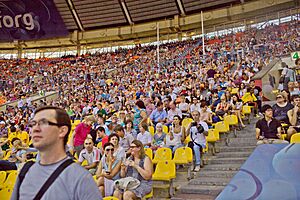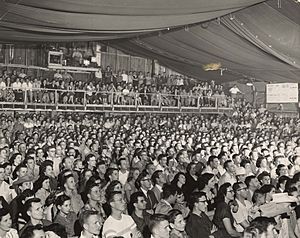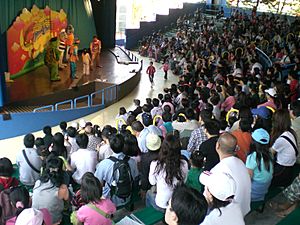Audience facts for kids
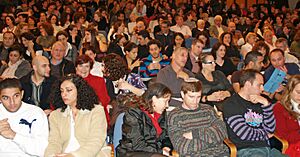
An audience is a group of people who watch or listen to something. They might be at a show, a concert, or a sports event. Audiences also include people who read books, play video games, or watch movies.
People in an audience take part in different ways. Some events ask the audience to join in. Others only allow polite clapping or quiet reactions.
Studying audiences has become an important part of learning about media. Audience theory helps us understand how audiences work. It shows how audiences affect art and how art affects them. The biggest type of art is the mass media. This includes movies, video games, and radio shows. Audiences influence these through their reviews and recommendations.
Today, it's easy to join in online. People can even act like journalists. An American journalist, Jeff Jarvis, once said: "Give the people control of media, they will use it." This means if people can share their thoughts, they will. Tom Curley, who led the Associated Press, also said that users decide how they want to engage with media. They choose what app, device, time, and place they use.
Contents
Different Kinds of Audiences
Real-Life Audiences
In public speaking, some audiences depend on the situation. They are made up of specific people. These audiences can be convinced by a speaker's ideas. They can be small or large. Sometimes, different groups come together to form one big audience.
Immediate Audiences
An immediate audience is a group of people who are right in front of a speaker. They listen directly to a speech or watch a performance. They are there at the same time and place. To see how an immediate audience reacts, you can look at their applause. You can also listen to their comments during or after a speech.
Mediated Audiences
Mediated audiences are different from immediate ones. These people experience a performance or speech from a distance. They might watch it on TV, listen on the radio, or see it on the internet. These tools separate the speaker from the audience. It can be hard to know the exact size of a mediated audience. This is because they are not in the same place as the event. Companies use polls and ratings to measure how many people are watching or listening. They also check comments on websites. This helps them understand what people think about movies, songs, and more.
Imagined Audiences
Imagined audiences are not real groups of people. Instead, they are audiences that a speaker or writer thinks about. This helps them plan their speech or writing. It also helps critics understand a text.
The Audience of Self
When a speaker thinks deeply about their own ideas, they are talking to their "audience of self." They question and consider what they are saying. Scholars Chaïm Perelman and Lucie Olbrechts-Tyteca said that a speaker is best at testing their own arguments. This "audience of self" helps speakers find the best ways to convince others.
The Universal Audience
The universal audience is an imagined group of people from all backgrounds. A speaker uses this idea to test if their message is fair and strong. The idea is that the message should convince anyone, no matter who they are. Perelman and Olbrechts-Tyteca believed that a message for a universal audience must seem true and timeless. Some people think this idea is too perfect. But it can still guide speakers to be ethical. It also helps readers understand a message better.
The Ideal Audience
An ideal audience is the specific group a speaker wants to reach. When creating a speech, a speaker imagines who their target audience will be. This is the group they want to persuade or affect. This imagined audience helps the speaker choose the best ways to connect with them. By thinking about this ideal audience, a speaker can guess how they might react. They can also think about their size, age, and shared beliefs.
The Implied Audience
An implied audience is an imaginary audience that a reader or listener figures out from a text. It's not the real audience, but the one the text seems to be written for. Communications scholar Edwin Black talked about the "second persona." This is the idea of the audience that the text creates. A critic can also guess what the text wants that audience to do or become.
Audiences on the Web
The internet gives everyone a chance to take part in different ways. It lets people write and share their ideas with others who are interested. When writers post online, they can form communities with people who share their hobbies. The audiences they reach can be general or very specific. This depends on what the writer is talking about. Audiences need to check in regularly to stay updated. Writers need to find their special topic and join existing communities. The internet allows these connections to form and grow. In his book Here Comes Everybody, Clay Shirky shows how audiences don't just receive content. They also create it. The internet lets you be both an audience member and a creator at the same time.
Audience Participation
Audience participation often happens in shows that break the fourth wall. This means the performers talk directly to the audience. Good examples include British pantomime shows and stand-up comedy. Creative stage shows like Blue Man Group also involve the audience.
Some people might feel shy about audience participation. But it's becoming a popular way for companies to connect with their customers. Brands want to build a special bond with people. So, they are using events that get the audience actively involved. Often, companies give out branded items at events. These items involve the audience in the show. They also act as souvenirs, helping people remember the brand. For example, at Super Bowl XLVIII, the audience became part of the halftime show's lighting effects. Pepsi gave spectators "video ski hats" that created cool visuals across the crowd.
By connecting with people's emotions, brands can get feedback from them. Companies that create these experiences call it "crowd activation." For instance, Tangible Interaction has a branch called Crowd Activation. PixMob also calls itself a crowd activation company.
One very famous example of audience participation is with The Rocky Horror Picture Show. This movie and its stage version, The Rocky Horror Show, have a huge fan following. The audience participation is so important that the DVD even has an audio option for it.
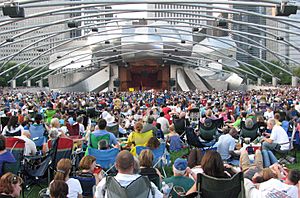
Examples of Audience Participation
In The Rocky Horror Picture Show (1975), the audience makes "call backs." They yell at the screen during certain parts of the movie. Also, people throw props and use them during specific scenes.
The Blues Brothers (1980) is another movie with audience participation. At the Valhalla Cinema in Melbourne, Australia, it became a regular show. The director, John Landis, even thanked the fans. He invited some regular attendees to appear in Blues Brothers 2000 (1998). These fans acted as part of the crowd during the song "Ghost Riders in the Sky".
In British pantomime shows, the audience is very important. They are expected to do certain things:
- Talk to an "audience friend" character. This character is often funny and friendly, like Buttons from "Cinderella". For example, Buttons might say "Hiya gang!" and the audience replies "Hiya Buttons!"
- Have back-and-forth arguments with characters. These are usually simple phrases like "No there isn't!" and the audience replies "Yes there is!"
- Do "ghost gags." Here, the audience yells loudly to warn a character about danger. The character usually doesn't know the danger is there.
The Complete Works of William Shakespeare (Abridged) divides the audience into groups. Each group calls out the concerns of a different part of a character's mind.
In The Mystery of Edwin Drood, a Broadway theatre musical, the audience votes. They choose who they think the murderer is. They also vote on the detective's true identity and which couple ends up together.
The 1984 Summer Olympics featured card stunts. The audience held up colored cards to create large pictures.
Tony n' Tina's Wedding involves the whole audience. It's a show set at a wedding, and the audience plays the role of "guests."
The British panel game QI often lets the audience try to answer questions. The audience has won one show and come in last in another.
Magic shows often need some audience participation. The illusionist Derren Brown uses a lot of audience participation in his live shows.
During performances of the "Radetzky March", it's a tradition for the audience to clap along. They clap to the beat during the louder parts of the song. This is very common at the Neujahrskonzert.
Bloggers, YouTubers, and live streamers often let their viewers leave comments. These comments can be checked by the creator or not.
Some music groups often include audience participation in their live shows. The superhero-themed comedy rock band The Aquabats do this a lot. They have "pool floatie races" where band members float across the crowd. They also give the audience plastic balls to throw at costumed "bad guys" on stage. Koo Koo Kanga Roo, a comedy dance-pop duo, write their music just for audience participation. They use call and response songs. These songs usually have a simple dance move that the band encourages the audience to follow.
Faux Participation
The TV show Mystery Science Theater 3000 showed a man and his robots. They were forced to watch "bad" movies. To stay sane, they talked and heckled the movies.
In a similar way, the website Television Without Pity had reviewers. They used language like audience members, not scholars. Sometimes, they acted as if they were also being "tortured" by the shows.
See also
 In Spanish: Espectador para niños
In Spanish: Espectador para niños


